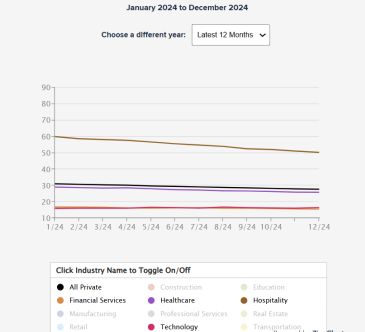Employee Turnover Rates on the Decline, But Challenges Remain
March 3, 2025 | By Nobscot Corporation
 The latest data from the U.S. Bureau of Labor Statistics shows that voluntary employee turnover in private industries declined steadily throughout 2024, marking a shift from the higher resignation rates of recent years. After starting the year at a 31.1% annualized rate, turnover fell to 27.8% by December. While this is a positive trend, it remains above pre-pandemic levels, meaning retention challenges are far from over.
The latest data from the U.S. Bureau of Labor Statistics shows that voluntary employee turnover in private industries declined steadily throughout 2024, marking a shift from the higher resignation rates of recent years. After starting the year at a 31.1% annualized rate, turnover fell to 27.8% by December. While this is a positive trend, it remains above pre-pandemic levels, meaning retention challenges are far from over.
Industry Breakdown: Who's Winning the Retention Game?
Some industries saw significant improvement in turnover rates, particularly those hit hardest by the labor market turbulence of the past few years.
- Hospitality experienced the most dramatic drop, from 60% at the start of the year down to 50.3%. While still the highest among all industries, this decline signals increased stability in a sector long plagued by high turnover.
- Healthcare followed suit, falling from 29.1% to 25.9%, a promising shift as organizations focus on retention strategies amid ongoing staffing shortages.
- Financial Services also saw progress, dropping from 16.8% to 15.6%, continuing a multi-year trend of gradual improvement.
State-by-State: Where Turnover Is Lowest-and Highest
Turnover rates varied widely across the U.S., largely reflecting the dominant industries in each region.States with the lowest turnover in 2024:
- Massachusetts: 17.2% (down from 18.5%)
- New York: 19.7% (holding steady from 19.6%)
- California: 20.1% (a significant improvement from 22.8%)
States with the highest turnover:
- Montana: 36.6% (down from 39.7%)
- Wyoming: 36.1% (slightly lower than 37.2%)
- Idaho: 33.7% (down from 37.2%)
What This Means for Employers
With turnover rates generally declining, it's tempting for companies to breathe a sigh of relief. However, the fact remains: Employee turnover is one of the largest hidden costs for employers. While layoffs and hiring slowdowns have temporarily reduced job-hopping, employees-especially high performers-will continue to leave if organizations fail to identify and reduce the workplace irritations that are driving turnover in their companies. The Financial Impact of Reducing Turnover On the plus side, HR executives can help their companies save an enormous amount of money, even with small reductions in turnover. Consider a company with 2,500 employees experiencing a 30% voluntary turnover rate-meaning 750 employees leave per year. With an average turnover cost of $15,000 per employee, the company is losing $11.25 million annually to turnover-related expenses.If that company reduces its turnover to 25%, annual departures drop to 625 employees, providing a savings of nearly $1.9 million per year.
Beyond the financials, lowering turnover also fosters greater workforce performance, improved client service, reduction in errors, and stronger business continuity-key factors for long-term success.
Key Takeaways for Employers:
- HR has a role to play. Tracking and reducing employee turnover is a direct way that Human Resource Executives can contribute to the financial health and success of the company.
- Retain your top talent. Even in an uncertain economy, voluntary turnover can spike for a a variety of reasons, especially if employees feel overburdened or undervalued after layoffs. Paying attention to employee retention today will pay off when the cycles revert back tomorrow.
- Use data to guide retention strategies. Industry and state-specific trends can help organizations benchmark their turnover rates, but the reasons for turnover vary from company to company. Use exit interviews and other employee surveys to understand the "why" behind your turnover, and then use that data to make changes that matter.
At Nobscot, we help companies retain top talent by identifying the root causes of turnover and providing actionable solutions. If you'd like to learn how data-driven insights can strengthen your retention strategy, contact us at info@nobscot.com or sign up for a demo and discussion at: https://nobscot.com/library/demo_request.cfm
Nobscot, the leader in employee turnover management technology for over 20 years, helps companies retain their best and brightest.

